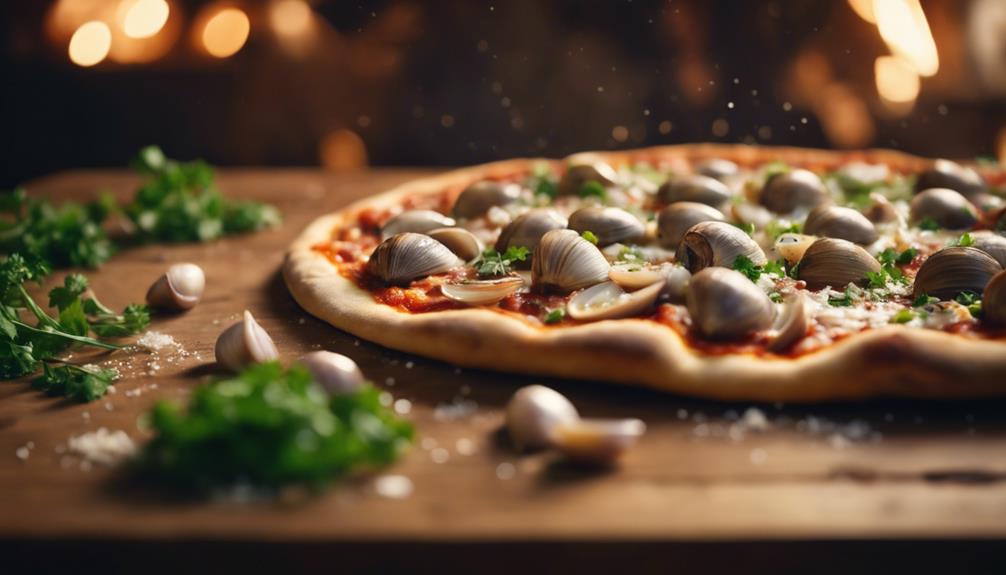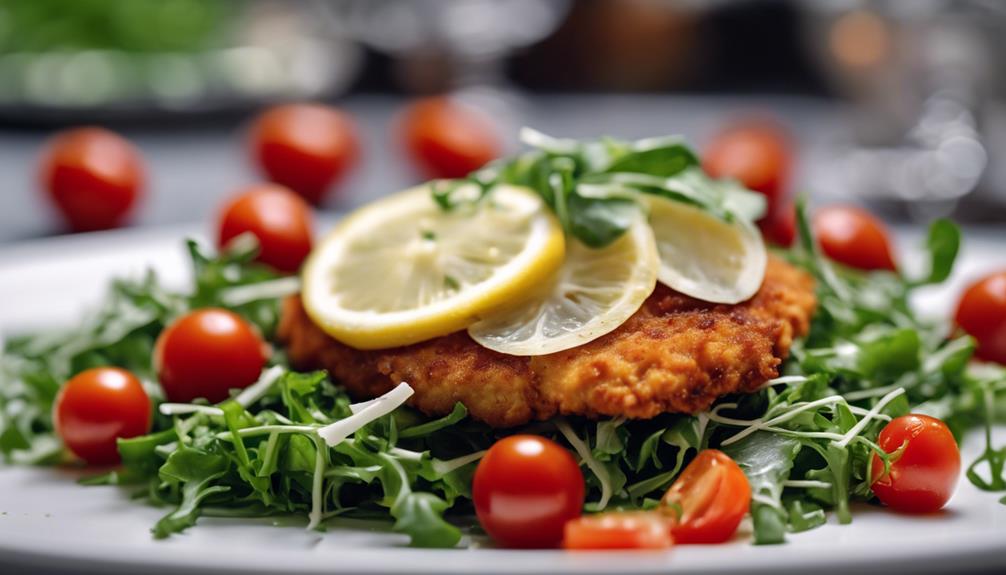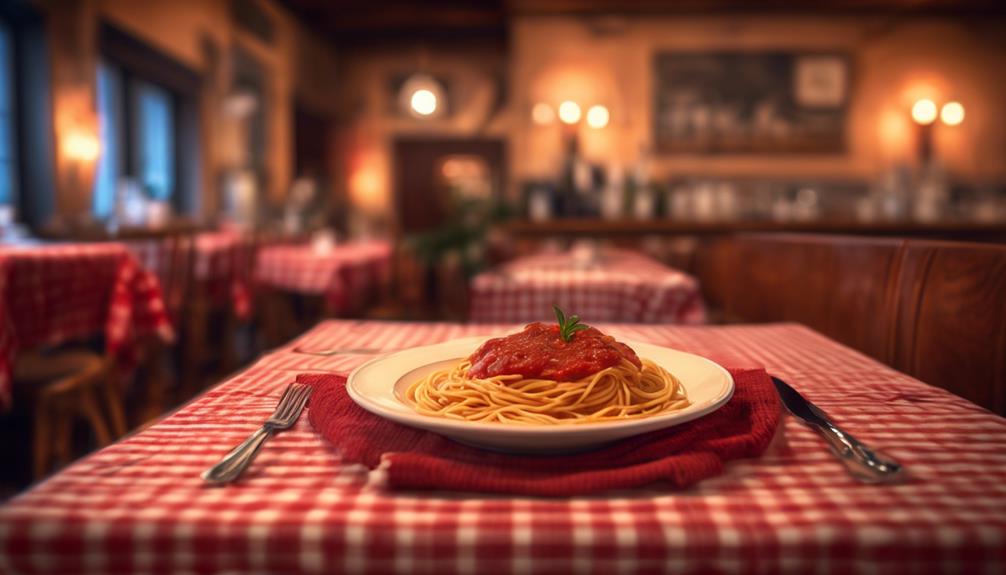Explore the detailed process of creating a delicious clam pizza, incorporating the flavors of the sea with the classic pizza tradition. Enjoy the decadent taste as you expertly steam fresh clams, ensuring a mouthwatering seafood experience. Enhance your cooking skills by skillfully adding the savory clams onto a crispy, golden-brown crust, blending textures and flavors perfectly. Impress your guests with this culinary masterpiece and enjoy a memorable dining experience together. Consider wine pairings to elevate the meal even further. Follow tips on storing leftovers to savor the delightful flavors for days to come.
Key Takeaways
- Incorporate fresh littleneck clams for authentic seafood flavor.
- Steam clams until open and remove meat delicately.
- Top pizza with clams, garlic, oregano, and pecorino-romano cheese.
- Bake at 500°F for 8 mins for a crispy crust.
- Pair with Sauvignon Blanc or Pinot Grigio for a delightful experience.
Ingredients
To make a delicious clam pizza, gather fresh littleneck clams, garlic, oregano, and Pecorino-Romano cheese as your key ingredients. The star of this seafood delight is unquestionably the clam. These briny bivalves, once shucked, are delicately placed atop the pizza before baking, infusing each bite with a taste of the ocean.
The combination of flavors from the tender clams, pungent garlic, aromatic oregano, and sharp Pecorino-Romano cheese creates a symphony of savory notes that seafood enthusiasts crave. Quality ingredients are paramount when crafting a memorable white clam pizza. Opting for fresh, high-quality clams ensures a superior taste experience.
The distinct flavor profile of the clam, when paired with the richness of the cheese and the earthiness of the oregano, elevates this seafood pizza to a culinary masterpiece. It's no wonder that white clam pizza has become a sought-after choice for those seeking a unique twist on the traditional pizza.
Preparing the Dough
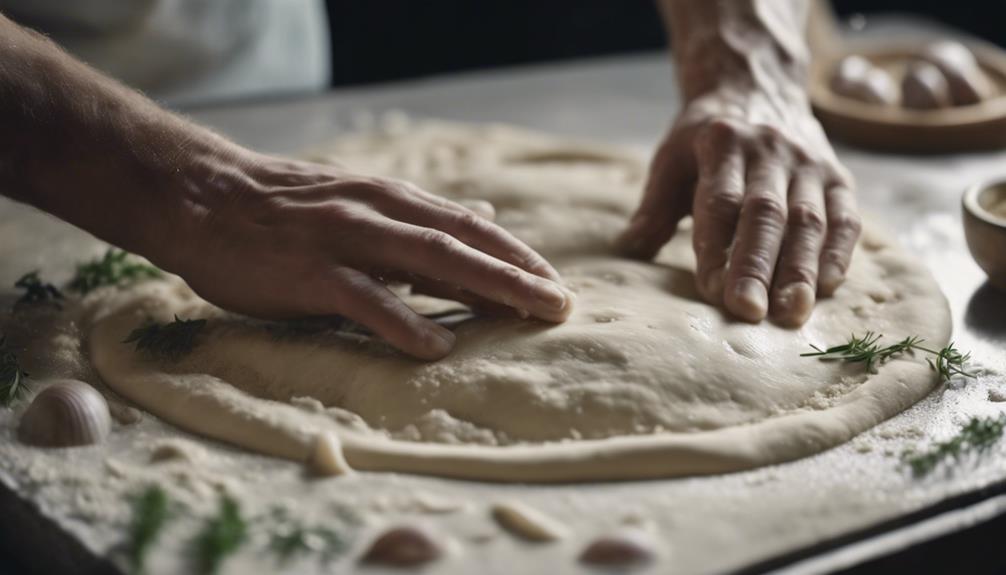
When making clam pizza, start by preparing the dough using a combination of bread flour and white whole wheat flour for a balanced texture. Knead the dough properly to develop gluten, resulting in a stretchy and elastic consistency. Proof the dough at room temperature or in a warm area to allow it to rise and develop flavor. Preparing the dough in advance and letting it rest in the refrigerator overnight can enhance the overall taste and texture of the pizza. Rolling out the dough to the desired thickness and shape is essential for achieving a crispy yet chewy crust when baked.
| Dough Preparation Tips | Description |
|---|---|
| Use bread flour and whole wheat | Provides a balanced texture for the clam pizza dough. |
| Proper kneading is essential | Develops gluten, creating a stretchy and elastic consistency. |
| Proof the dough for flavor | Allowing it to rise at room temperature or in a warm area enhances taste. |
| Rest dough in the refrigerator | Overnight rest improves overall taste and texture of the clam pizza. |
| Roll out dough for best results | Achieve a crispy yet chewy crust by shaping the dough to desired thickness. |
Steaming the Clams
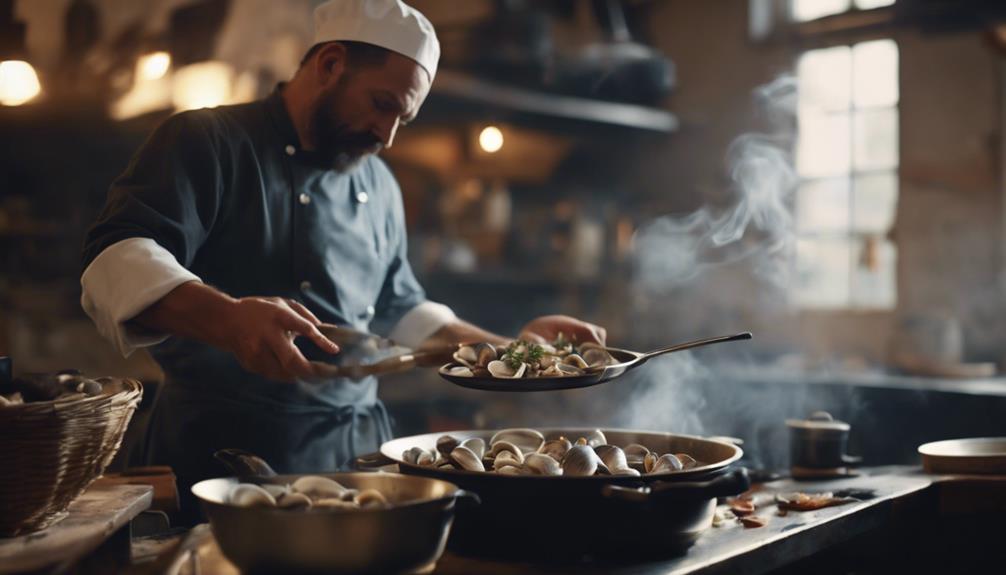
When steaming clams, make sure they're cooked until they open, indicating they're ready to be removed from their shells.
Using fresh clams is crucial for the best flavor and texture in your clam pizza.
The steaming process helps extract the natural juices and flavors of the clams, enhancing the overall taste of your pizza.
Cooking Clams Properly
Steam the clams until they open up, indicating they're cooked and ready to be shelled. This step is important in preparing the white clam pizza, as steaming helps retain the natural juices and flavors of the clams, ultimately enhancing the taste of the pizza.
Properly cooked clams should be delicately removed from their shells and added to the pizza just before baking to avoid overcooking. Steaming the clams is a rapid and simple technique that ensures they're cooked through and tender, making them the ideal topping for a flavorful clam pizza.
It's essential to use fresh clams and steam them correctly to achieve the desired texture and flavor for your homemade white clam pizza. By following these steps and paying attention to the details of steaming the clams, you can create a delicious seafood twist on the classic pie that's sure to impress your taste buds.
Adding Flavor to Clams
Enhancing the flavor of clams through steaming involves opening the shells to release their juices and create a delicious base for your clam pizza.
When steaming clams, it's important to make sure they're only cooked until they open. Overcooking can lead to a rubbery texture, affecting the overall taste of your dish.
To steam clams effectively, a pot with a small amount of water or broth can be used to cook them quickly. The liquid that's released by the clams during steaming holds a rich flavor that can elevate the sauce or broth you're preparing, adding depth to your clam pizza.
Remember, fresh clams should be tightly closed before steaming; any clams that remain closed after cooking should be discarded.
Incorporating Clams Into Pizza
To prepare clams for your pizza, start by steaming them until they open up, allowing for easy removal of the meat from the shells. Steaming the clams is crucial to make sure they are fully cooked and ready to be added to your white clam pie before baking. This method not only cooks the clams but also facilitates the separation of the meat from the shells, making it simpler to incorporate them into your pizza topping.
Here is a helpful table to guide you through the process of steaming clams for your delicious white clam pie:
| Steps | Details |
|---|---|
| 1. Purchase Clams | Choose fresh clams from a reputable source for the best flavor. |
| 2. Clean Clams | Scrub the clams under cold water to remove any dirt or sand. |
| 3. Steam Clams | Place the clams in a pot with a small amount of water and steam until they open. |
| 4. Remove Meat | Take out the cooked clam meat from the shells for pizza topping. |
| 5. Chop or Leave Whole | Decide whether to chop the clams or leave them whole based on preference. |
Following these steps will guarantee your white clam pizza turns out flavorful and satisfying, with perfectly cooked clams enhancing every bite.
Assembling the Pizza
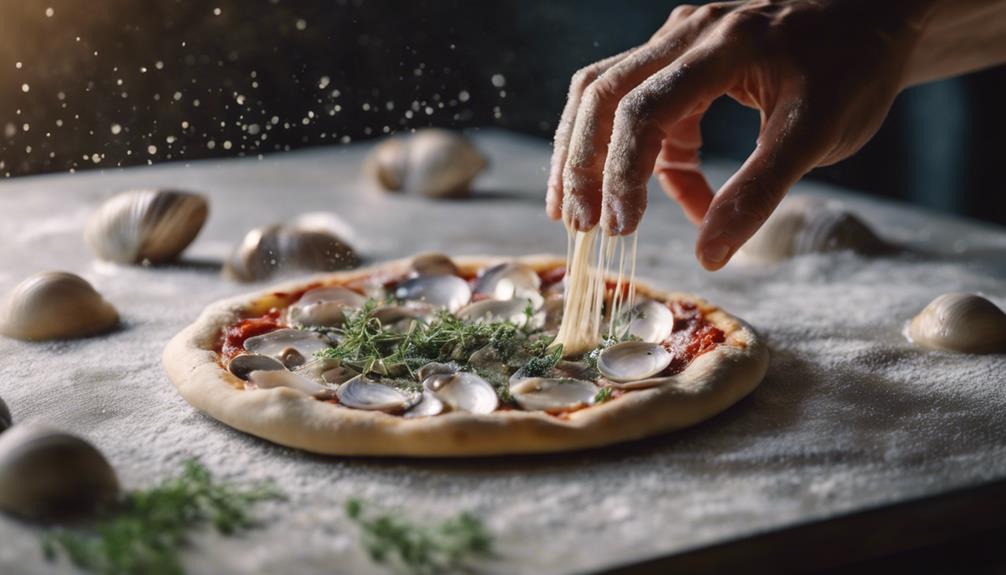
Spread olive oil and minced garlic over the dough to create a flavorful base for your clam pizza.
Once the dough is prepared, generously top it with shredded mozzarella cheese, which will melt into gooey perfection as the pizza bakes.
The star of the show, freshly steamed littleneck clams, should be shucked and evenly distributed across the pizza's surface. These briny morsels will infuse the dish with a taste of the sea, enhancing each bite with their unique flavor.
To add a touch of saltiness and depth, sprinkle pecorino romano cheese over the clams. This final layer of cheese will create a harmonious balance of flavors in the finished pie.
As you assemble the pizza, make sure that each component is spread out evenly to guarantee a consistent taste throughout. The careful arrangement of ingredients will contribute to a delicious outcome when the pizza is baked to perfection.
Baking to Perfection
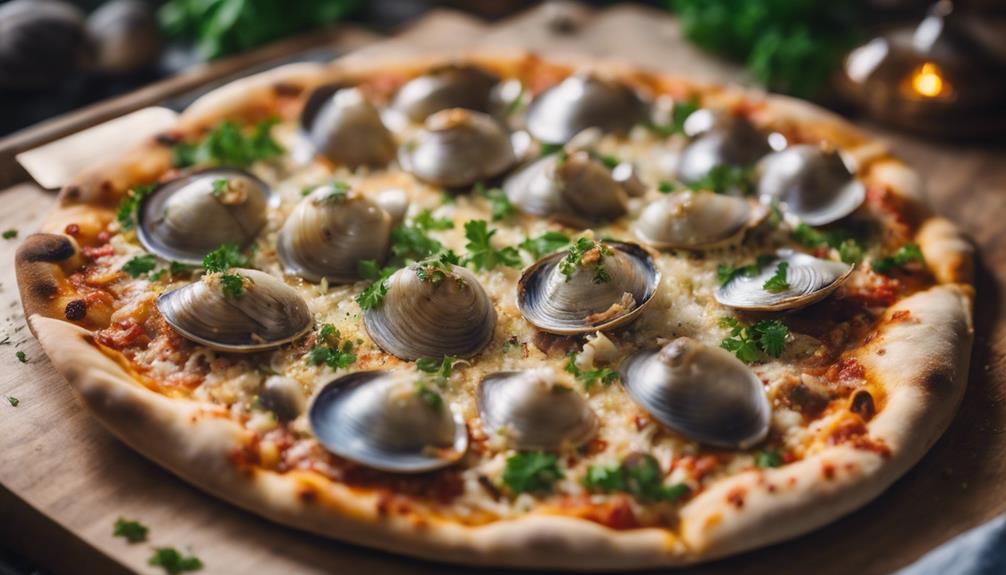
When baking your clam pizza, achieving a crispy crust is vital for a delightful texture.
The oven temperature of 500°F guarantees that the cheese melts perfectly and the clams cook just right.
Timing is essential to reach the pinnacle of perfection in your seafood pizza creation.
Crispy Crust Secrets
How can you achieve the perfect crispy crust for your clam pizza?
To guarantee a delightful crunch in every bite, preheat your oven to a scorching 500°F. This high temperature is crucial to achieving that sought-after crispiness while maintaining a tender interior.
When preparing your pizza, opt for a pizza stone or baking sheet dusted with cornmeal to prevent sticking and enhance the crust's texture. Shape the dough thinly and evenly to promote consistent crispiness throughout.
Once your pizza is assembled, bake it for approximately 8 minutes, or until the crust turns a beautiful golden brown, signaling its crisp perfection.
Oven Temperature Tips
To achieve the ideal bake for your clam pizza, make sure your oven is preheated to a scorching 500°F. The high temperature is essential for achieving a crispy crust while thoroughly cooking the clams and other toppings. It's important to maintain this heat by refraining from frequently opening the oven door, as fluctuations can affect the baking process. Keep a close eye on your clam pizza while it's in the oven to prevent burning at such high temperatures. Once the pizza is done, allow it to rest briefly. This resting period lets the flavors of the clams and other ingredients meld together, enhancing the overall taste of the pizza.
| Oven Temperature Tips | |
|---|---|
| Preheat to 500°F | Avoid opening oven door frequently |
| Monitor pizza closely | Allow pizza to rest post-baking |
Timing for Perfection
Maintaining the high heat of 500°F in the oven for precisely 8 minutes is key to achieving a crispy crust and perfectly cooked clam pizza with melted cheese. This timing allows the high baking temperature to swiftly cook the clams without risking overcooking, preserving their freshness and flavors.
The brief baking time also guarantees that the seafood toppings retain their natural essence, enhancing the overall taste of the pizza. As the pizza bakes, keep an eye on the crust's color – a golden brown hue indicates that it's ready to be savored.
Proper timing in the oven is essential, as it plays a significant role in maintaining the delicate balance of textures and flavors in the clam pizza. By adhering to this precise timing, you can enjoy a delectable seafood twist on a classic pie that showcases the briny goodness of clams harmoniously combined with gooey melted cheese on a crispy crust.
Adding the Final Touches
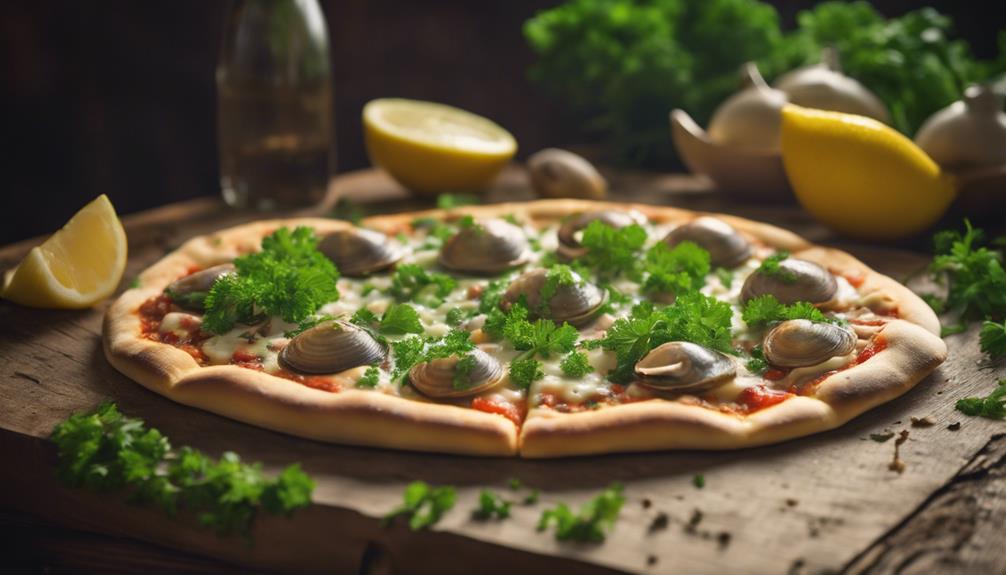
Sprinkle grated pecorino romano cheese generously over the olive oil-tossed clams to enhance the flavors before baking the pizza to perfection. The addition of this sharp and salty cheese complements the briny taste of the clams, creating a harmonious blend of flavors that will tantalize your taste buds.
As the pizza bakes, the cheese will melt and form a golden crust, adding a deliciously crispy texture to each bite.
Once the pizza is ready, the clams will be heated through, releasing their savory juices and infusing the pizza with their distinct seafood essence. The final touches of pecorino romano cheese and perfectly cooked clams are essential components of the New Haven style clam pizza experience, offering a unique twist on the classic pie that seafood lovers will appreciate.
Now that the pizza is baked to perfection with the added final touches, it's time to slice it into wedges and serve it hot. This seafood-infused masterpiece is ready to be enjoyed, providing a delightful culinary experience for all who indulge in its flavors.
Serving and Enjoying
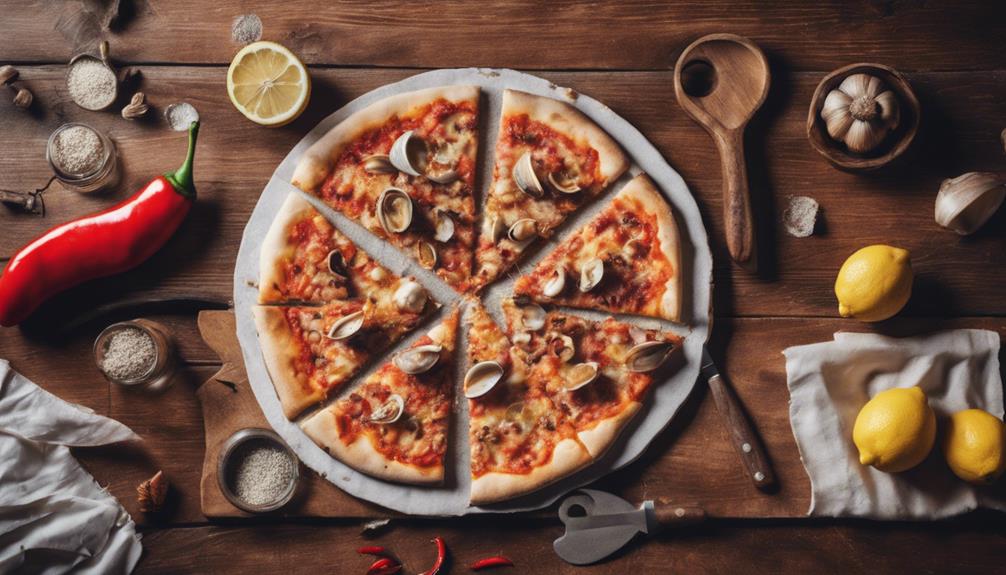
Once the clam pizza is hot and ready to serve, the next step is to savor and enjoy each flavorful bite with your loved ones. Here are some tips to enhance your clam pizza experience:
- Engage your senses: Take a moment to appreciate the aroma of the freshly baked pizza, allowing the scent of the clams to whet your appetite.
- Explore the flavors: Delight in the burst of seafood flavor from the shucked clams, complemented by the richness of pecorino romano cheese that blankets the pizza.
- Savor each bite: As you bite into the slice, notice the blend of textures – the softness of the clams contrasting with the crispy crust and gooey cheese.
- Share the experience: Invite your friends and family to join in the culinary adventure, sharing stories and creating lasting memories around the table with this unique New Haven style clam pizza.
Wine Pairing Suggestions
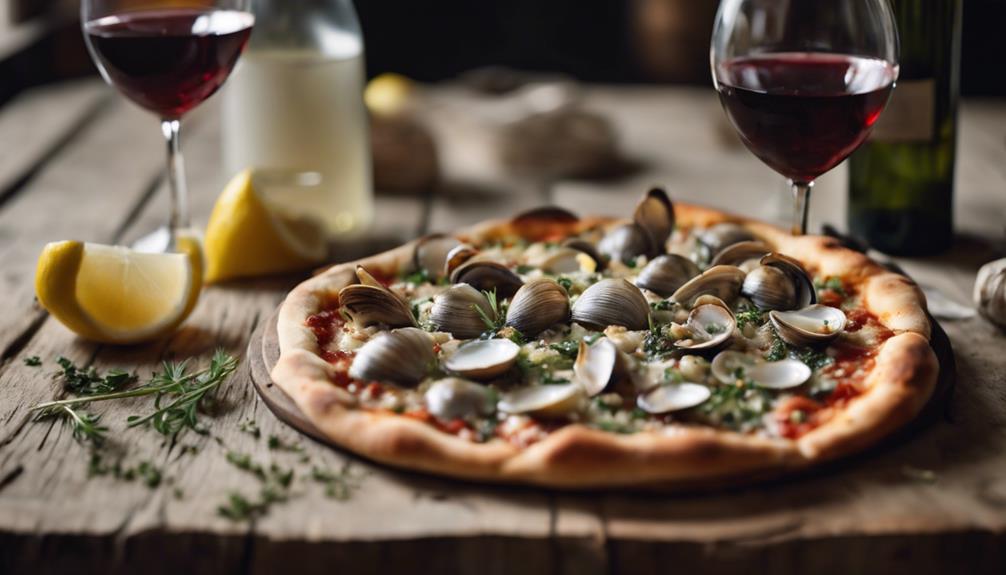
Consider enhancing your clam pizza experience by choosing the perfect wine pairing to complement the flavors of the dish.
When it comes to white wine, opt for a light-bodied Sauvignon Blanc or Pinot Grigio to harmonize with the briny essence of the clams.
If you prefer a more acidic touch, a Chardonnay or Vermentino can intensify the seafood notes in your pizza.
For a daring fusion, indulge in a bubbly glass of Prosecco or Champagne to elevate your Clam Pizza experience.
If rosé is your preference, select a fruity variation to enhance the seafood flavors.
Even if you lean towards red wines, a light-bodied Pinot Noir can still be a suitable match for the Clam Pizza, complementing its flavors without overpowering them.
Experiment with these wine pairings to find the perfect accompaniment to your seafood-inspired pizza.
Tips for Leftovers
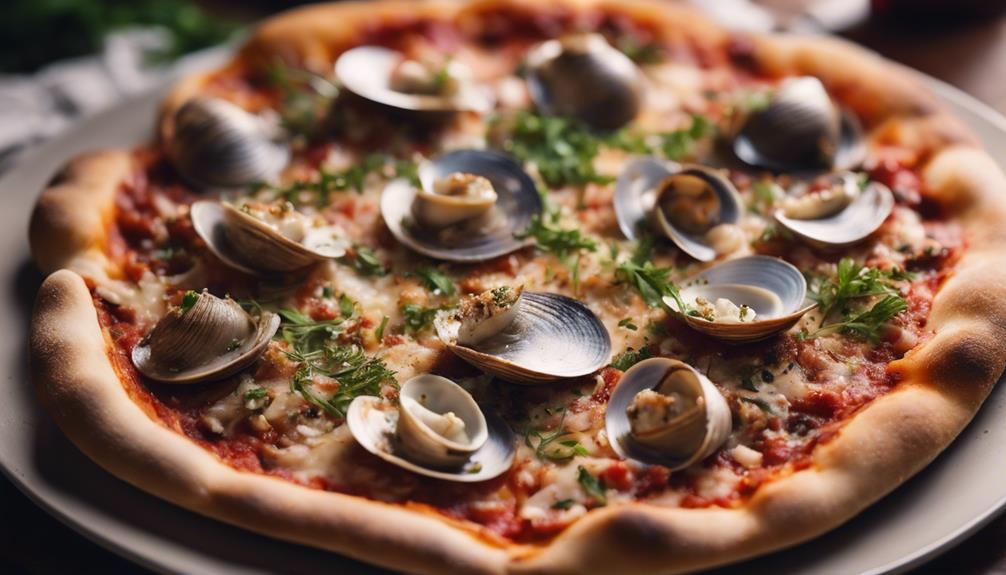
To maximize your clam pizza experience, make sure you know how to handle any leftovers effectively. Here are some tips for dealing with leftover clam pizza:
- Storage: Store leftover clam pizza in an airtight container in the refrigerator for up to 3 days to maintain freshness.
- Reheating: Reheat leftover clam pizza in a preheated oven at 350°F for about 10-15 minutes for the best results, ensuring the crust remains crispy.
- Avoid Microwaving: Avoid microwaving leftover clam pizza as it can make the crust soggy and diminish the flavors.
- Refresh with Fresh Toppings: Consider adding fresh toppings like arugula or cherry tomatoes to refresh leftover clam pizza and enhance its flavors when reheating.
For longer storage, freeze leftover clam pizza slices individually wrapped in foil or plastic wrap. By following these tips, you can enjoy your clam pizza even more, making the most out of every slice.
Frequently Asked Questions
What Is Clam Pizza Called?
You call clam pizza 'White Clam Pizza' or 'Clam Pie.' It's a seafood twist on a classic pie, featuring fresh littleneck clams, garlic, cheese, and olive oil. This delicious combination is a favorite in New Haven, Connecticut.
What Ingredients Are on a Seafood Pizza?
Seafood pizzas typically include ingredients like clams, shrimp, calamari, or anchovies. They might have a white sauce base, garlic, herbs such as oregano or basil, and a mix of cheeses for a flavorful twist.
Where Did Clam Pie Originate?
Clam pie originated in New Haven, Connecticut. The iconic white clam pie, with its thin crust and fresh littleneck clams, was first created at Frank Pepe Pizzeria Napoletana in the 1960s. Its unique flavors have made it a nationwide favorite.
How Many Calories Are in a White Clam Pizza?
Curious about the calorie count in a white clam pizza? It typically ranges from 250-300 calories per slice. Varying based on ingredients and size, this seafood twist on a classic pie offers lean protein with fewer calories.
How Did Clam Pizza Become a Seafood Twist on a Classic Italian Dish?
Clam pizza became a seafood twist on a classic Italian dish thanks to the addition of a shocking ingredient in Italian cuisine: clams. This unconventional topping provides a burst of briny flavor and texture, creating a unique and memorable dining experience for those seeking a departure from traditional pizza options.
Conclusion
Indulge in the delectable flavors of clam pizza, a unique twist on a traditional favorite that will transport your taste buds to a seaside paradise.
With each bite, savor the savory combination of tender clams, tangy sauce, and gooey cheese, all baked to perfection on a crispy crust.
Experience a culinary journey like no other with this seafood-inspired pizza that's sure to leave you craving more.
